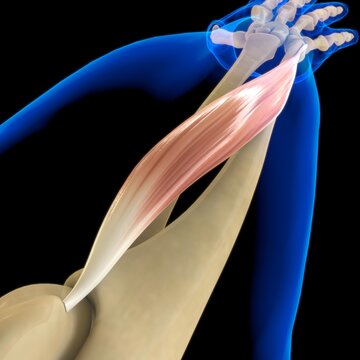
Extensor carpi ulnaris (ECU) tendinopathy
What Is ECU Tendinopathy?
Firstly, the ECU is a long, thin skeletal muscle that has its origins proximal over the lateral epicondyle of the elbow joint and proximal attachment to the base of the 5th metacarpal. Its primary role is to facilitate the extension and ulnar deviation of the wrist joint. However, its function has been found to change depending on the forearm position. In forearm supernation, the tendon lies dorsally in terms of the wrist flexion/extension axis, therefore giving it a greater contribution to wrist extension. In forearm pronation, the tendon sits in more of a palm and ulnar deviated position. In this position, there is up to a 60% depletion in wrist extension from ECU (Horii et al., 1993). Hence, the position of largest tension stress for the tendon retinaculum is that of forearm supernation, wrist flexion and ulnar deviation (Campbell et al., 2013). Therefore, tendinopathy of the ECU is defined as the failed healing response of the ECU tendon in response to repetitive stress and or trauma.
What causes this condition?
ECU tendinopathy is primarily caused by a sudden increase in training load or actuate trauma. The repetitive loading places additional strain on the collagen matrix which exceeded its load capacity, resulting in matrix breakdown. (Insert cite here). There may be an increase in vascularity and subsequent neural ingrowths. (Campbell et al., 2013)
Wrist extension and ulnar deviations are the primary actions of the ECU, therefore sports and activities that have these as a primary action are the most common in developing this condition. These include;
- Tennis players
- Golfers
- Rugby league
- Rowers
Common symptoms / signs
Subjective:
– Pain or dull ache on the ulnar side of the wrist, commonly over the ulnar styloid.
– Sudden change in load.
– Localised swelling (occasionally)
Objective:
- Tender on palpation over the ulnar styloid, potentially the ECU muscle belly.
- Pain or ache on Wrist extension and ulnar deviation
- Weakness in Handheld dynamometry grip strength in ulnar deviated positions.
Aggravators:
– Loaded positions: Pain is replicated when loaded the affected ECU tendon. Due to the change in the matrix structure and local inflammation, chemosensitivity and nociceptive drivers are increased. Leading to irritability of the tendon.
Eases:
– Relative rest will reduced the amount of blood flow to the distal UL’s. reducing inflammation and frequency of irratabilty.
– Pain medications
Common Differential Diagnosis:
- ECU tenosynovitis
- TFCC sprain
- Lunotriquetral Ligament sprain
- Carpel bones fracture
- Ulnar Styloid fractures
- Local Arthritis
- Ulnar nerve entrapment
Risk factors
– PMHx of ECU tendinopathy
– Current Wrist instability
– Rheumatoid Arthritis
– History of Racquet sports
– older age
– Genetic factors
– post menopausal women
(Wagner & Gottschalk, 2019) (Cardoso et al., 2019)
How is it treated?
Exercise is the primary treatment option for ECU tendinopathy. Initial swelling, if any, should be subsided before commencing tendinopathy principles. During this time, splitting around the wrist at approx. 30 deg extension may be beneficial, as well as an anti-inflammatory prescription. Activity modification should be educated and prescribed to the client for particularly aggravating movements of wrist extension and ulnar deviation with the load. From here, tendinopathy loading principles should be used to load the tendon correctly and, in a pain-free manner. This includes isometrics to begin, progressing into heavy slow resistance into plyometric exercises before RTP.(Cardoso et al., 2019)
Reference:
Campbell, D., Campbell, R., O’Connor, P., & Hawkes, R. (2013). Sports-related extensor carpi ulnaris pathology: A review of functional anatomy, sports injury and management. British Journal of Sports Medicine, 47(17), 1105–1111. https://doi.org/10.1136/bjsports-2013-092835
Cardoso, T. B., Pizzari, T., Kinsella, R., Hope, D., & Cook, J. L. (2019). Current trends in tendinopathy management. Best Practice and Research: Clinical Rheumatology, 33(1), 122–140. https://doi.org/10.1016/j.berh.2019.02.001
Horii, E., An, K. N., & Linscheid, R. L. (1993). Excursion of prime wrist tendons. The Journal of Hand Surgery, 18(1), 83–90. https://doi.org/10.1016/0363-5023(93)90250-7
Motsinger, S. K. (2020). Complete Anatomy. Journal of the Medical Library Association : JMLA, 108(1), 155. https://doi.org/10.5195/JMLA.2019.853
Wagner, E. R., & Gottschalk, M. B. (2019). Tendinopathies of the Forearm , Wrist , and Hand. 46(2019), 317–327.
